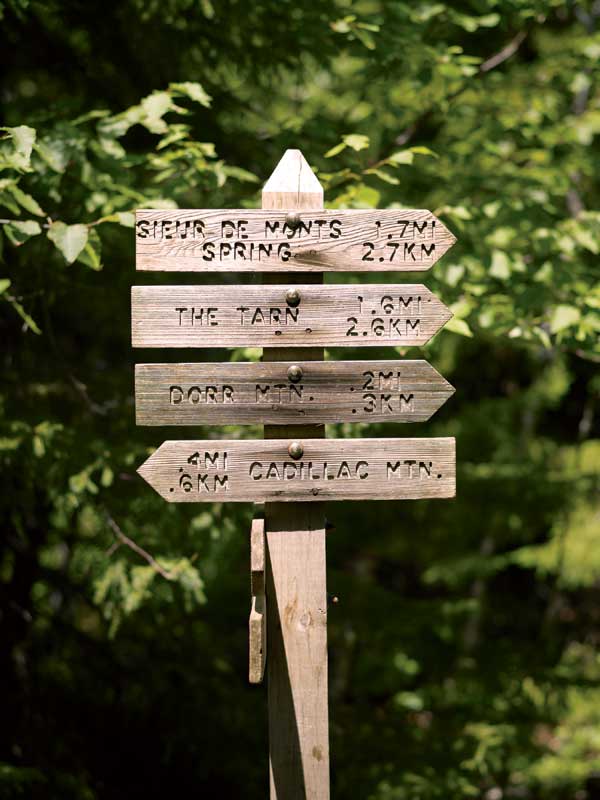Acadia National Park Hiking | Art of the Trail
Magnificent vistas along the miles of hiking paths and carriage roads in Acadia National Park are the result of man’s planning as much as nature’s hand.

Coffee By Design | Portland, Maine
Photo Credit : Katherine KeenanOn a cloudless August morning, I’m sitting atop The Beehive, an open, rocky hilltop in Acadia National Park that overlooks Sand Beach and the Gulf of Maine beyond. The sun is glinting off a dappled sea, lightly scored with iridescent ridges, like scales on a brook trout.Not a single other person is in sight. I hear only the sound of waves lapping, breezes murmuring in the conifers below me, and my heart thumping with perhaps a bit too much vigor. The ascent up this low knob follows a rugged path inscribed up the hillside about a century ago. The trail consists in part of ladders and rungs hammered into rock, providing access to one ledge and then another, each of which one traverses–one hand on the rock face for security, the other extended out into space like a tightrope walker’s–before coming to another set of rungs, or perhaps boulders crafted into steps. (The layered ledges give the hill its name.) When people think of Acadia, they think of it mostly as a refuge for nature; it’s been viewed as such since the first artists from Eastern Seaboard cities ventured here in the 1840s. But Acadia is no more a work of pure nature than Michelangelo’s David is a block of pure marble. The landscape and our access to it have been subtly crafted by generations of artists who designed and built an extensive network of trails: some 125 miles of footpaths and 45 miles of carriage roads suited to walking.

Photo Credit : Churchill, Christopher
A good many of the pathways of Acadia, like the Beehive Trail, were designed for aesthetic impact. Visitors may not realize it, but when they hike Acadia, they’re being manipulated every bit as much as when they stroll through the galleries of an art museum. That stunning view of Frenchman Bay that suddenly filled the northern horizon when I pulled myself up that ledge? That wasn’t happenstance. The view was, essentially, curated and put on display for me. Indeed, there’s a much easier way to ascend The Beehive: Just follow the trail through the woods around the north side and come up from behind. The view from the top is the same–yet it’s somehow diminished. The trail up the ledges was crafted with every bit of the precision of an Albrecht Duerer engraving. The artists here worked in the medium of trails; they were among the Old Masters of the big landscape.
Today I’m planning a full day in Acadia’s gallery, setting off on a nearly 12-mile hike, from Sand Beach halfway across the island’s eastern lobe to the civilized splendor of the Jordan Pond House. The route will take me across three peaks–including Cadillac Mountain, at 1,530 feet the park’s highest summit–sampling a broad collection of trails and trail types along the way.
At 9:15, I stand up, face northwest, and set off.
The tribes of Acadia hikers aren’t identifiable by dress–everyone here wears “Life is good” T-shirts and hats–but rather by the trail greetings they proffer. And today I have plenty of opportunity for classification, at least after cresting Champlain Mountain and beginning my descent. Bar Harbor’s excellent breakfast restaurants have apparently emptied out, and the trail population has started to swell.

Photo Credit : Churchill, Christopher
The most populous tribe I encounter are the “How’s-It-Going?”s followed by the “Much Farther?”s (a group, incidentally, that changes into the “Not Much Farther!”s when descending a hill). Another faction consists of the Grim Hikers, who soldier past with eyes to the ground and not so much as a grunt or a nod. A subset of the Grim Hikers clatters through the woods with a pair of extendable aluminum hiking sticks, scuttling like human/crab hybrids. They’re often unwilling to cede an inch of trail.
This diversity–kids, elders, crab-hikers–would no doubt please those who conceived and built the trails about a century ago. The idea was to provide access to visitors who might not otherwise find their way into the dramatic landscape, although the trail builders–folks such as Rudolph Brunnow, Herbert Jaques, Waldron Bates, and George Dorr–had a different population in mind, more the likes of Theodore Roosevelt-era women hiking in skirts, and high-collared Boston clerks seeking respite from dreary office life.
Over several years, the trails were built largely by volunteers, many of them affluent summer residents who passionately loved Mount Desert Island. They donated time and money and formed village improvement associations to cut hiking paths through the new preserve. (Eventually the federal government established Sieur de Monts National Monument in 1916, and then Lafayette National Park in 1919; it became Acadia in 1929.) George Dorr, in particular, stands out. A Boston textile heir utterly captivated by the island, he devoted much of his life to protecting the land and building trails. He seemed congenitally averse to the easiest routes; instead he built trails through fields of tumbled talus and across narrow ledges, always in search of a great view or an intriguing natural feature. If there was a fracture in a rock big enough to walk through, Dorr and his cohorts would find a way to route a trail through it.
Dorr Mountain was named after him, and that’s appropriate; the trails up the eastern face offer some of the best examples of the park’s distinctive aesthetic. As I ascend Dorr Mountain from a small pond called The Tarn, it’s clear to me that the trail builders had both stamina and a tremendous fondness for stairways. The ascent is a masterwork of a ziggurat: huge stone slabs edging along a smooth rock face here or past dour glacial erratics there.

Photo Credit : Churchill, Christopher
At higher elevations, smooth, lichen-streaked rock faces break through stunted forest like a friar’s pate, and here the trail builder’s art shifts from building to plotting. The route, linking one smooth rock face with a view to another, is marked here with artful stacks of stones called cairns, each one typically a large flat rock set across two smaller ones, much like a bench. This style was dubbed the “Bates cairn,” after Waldron Bates, another early trail advocate who’s sometimes called the “father of Acadia’s trail system.”
Bates was “a tireless walker and fearless climber,” wrote the noted landscape architect Beatrix Farrand. “He enjoyed nothing so much as working out a good path up an incredibly steep crag or finding a way between rock ledges to some quiet grove hidden in a fold of the mountain.”
The Bates cairns offer a simple, pleasingly druidic, way of finding one’s way across treeless uplands. I follow them across the rounded top of Dorr, then descend into a dusky col before ascending Cadillac Mountain, picking up the cairns again as I climb out of the beech and maples.
Nearing the top of the park’s tallest point, which is accessible by car, crowds thicken as drivers and their families spill out of minivans and sedans. I find myself now amid a new tourist ecosystem, occupied by a tribe that views nature not only as inspiration but also as a yawning pit of horrors; I hear much shouting for children to stay away from the edge, which is odd, since Cadillac Mountain lacks much of an edge. (The summit was sanded smooth by ancient glaciers.)

Photo Credit : Churchill, Christopher
I spend a few minutes trying to enjoy the summit, and in theory there are no obstructions to the view here. But the milling crowds, the glare from windshields in the parking lot, and the teeming gift shop offer larger if less tangible obstacles. I don’t linger long; leaving the commotion behind, I set off down the South Ridge Trail.
—
I’d be a liar if I reported that all trails at Acadia are hauntingly beautiful sculptures handcrafted of ancient rock. Take, for example, the West Face Trail down Cadillac. After turning off the ridge, I find that it hasn’t benefited much from the hand of man; it’s an unrelenting drop, crossing stretches of jumbled, angular boulders that tumbled down the mountain eons ago and came to rest with malice aforethought, their sharp corners facing up. I no longer feel as though I’m strolling through a pleasant gallery but instead am now involuntarily engaged in some reality-TV obstacle course, gingerly picking my way down–aware that a misstep may mean, if not certain death, then abrasions, inconvenience, and humiliation. I long for the stair builders.
I survive the descent with dignity mostly intact. At the base of the mountain I come to the shore of lovely Bubble Pond, encased in emerald hills. At the pond’s outlet I find a small stream. It’s obvious what I need to do: remove shoes, apply feet. While soaking and paying somewhat closer attention to moss than is customary for me, I catch glimpses of mountain bikers gliding specter-like through the forested hillside above. Recuperated and reshod, I walk up to investigate. And there I find myself back in Acadia’s spectacular trail gallery.
Acadia’s carriage roads are rightly famed for their beauty and grace. They were designed for an earlier era, yet suit ours perfectly. Broad and well-wrought of finely crushed stone, often edged with boulders, these gently winding roads have a medieval, fairytale-like quality, and you half expect a troop of knights to come galloping along, pennants fluttering. The roads were one of the grand extravagances of the early 20th century, built so that island denizens could take their horses and buggies out into the wilds, without suffering the indignity of unattractive sights or untidy lanes. Paid for largely by John D. Rockefeller Jr., they weave through forests, along streams, and (gradually, so as not to tax the horses) up hills, with ocean or lake views that blossom with every yard of elevation.

Photo Credit : Churchill, Christopher
Today the roads feel as though they were designed solely in anticipation of the invention of mountain bikes. They’re perfect for a slow afternoon’s pedal–but I find that they’re also perfect for walking. I started the day climbing, occupied with the rhythm of my heart, then moved into hiking, which involved complicated negotiations among feet, legs, and rocks. Now I’m moving loosely with a comfortable rhythm, and for the last four miles, I feel as though I’m on autopilot.
Climbing and hiking are adventures of the body; walking is more an adventure of the mind, a time when your thoughts can unspool in a leisurely way. Only once is my breath taken away: when I stop to admire the view of Jordan Pond from the carriage road along the base of Penobscot Mountain and I happen to glance down. The road was built atop a 20-foot rock wall painstakingly crafted out of a talus slope; the labor to provide me with this simple view seems nearly Egyptian.
—
I arrive at the Jordan Pond House a little more than eight hours after I departed Sand Beach. A low-angled sun casts deep shadows across the lawn running down toward the pond’s shore. The grass is scattered with tables and people enjoying tea and popovers, a 19th-century island tradition that’s managed to go feral here and survive. The tea drinkers seem in no hurry to leave–a number of them have sent out exploratory parties to gather blueberries at the lawn’s edge–and I inquire at the desk about the wait time. At least 25 minutes, the hostess tells me.
I look at my watch. Then I look out front and see the free Bar Harbor shuttle bus ready to pull out. I realize that I can be back in town before I’ll even be seated here at the cafe. Bar Harbor, I know, has a bountiful supply of cold and excellent beer, which begins to have a large effect on my imagination. Beer isn’t quite as civilized a beverage as tea, but it’s equally ancient and possessed of comparable restorative properties. And I figure I’ve had enough culture today in the galleries of Acadia. I walk outside, clamber aboard, and set off on the last leg of my day’s journey.
For maps, brochures, and seasonal schedules and fees:nps.gov/acad/index.htm




